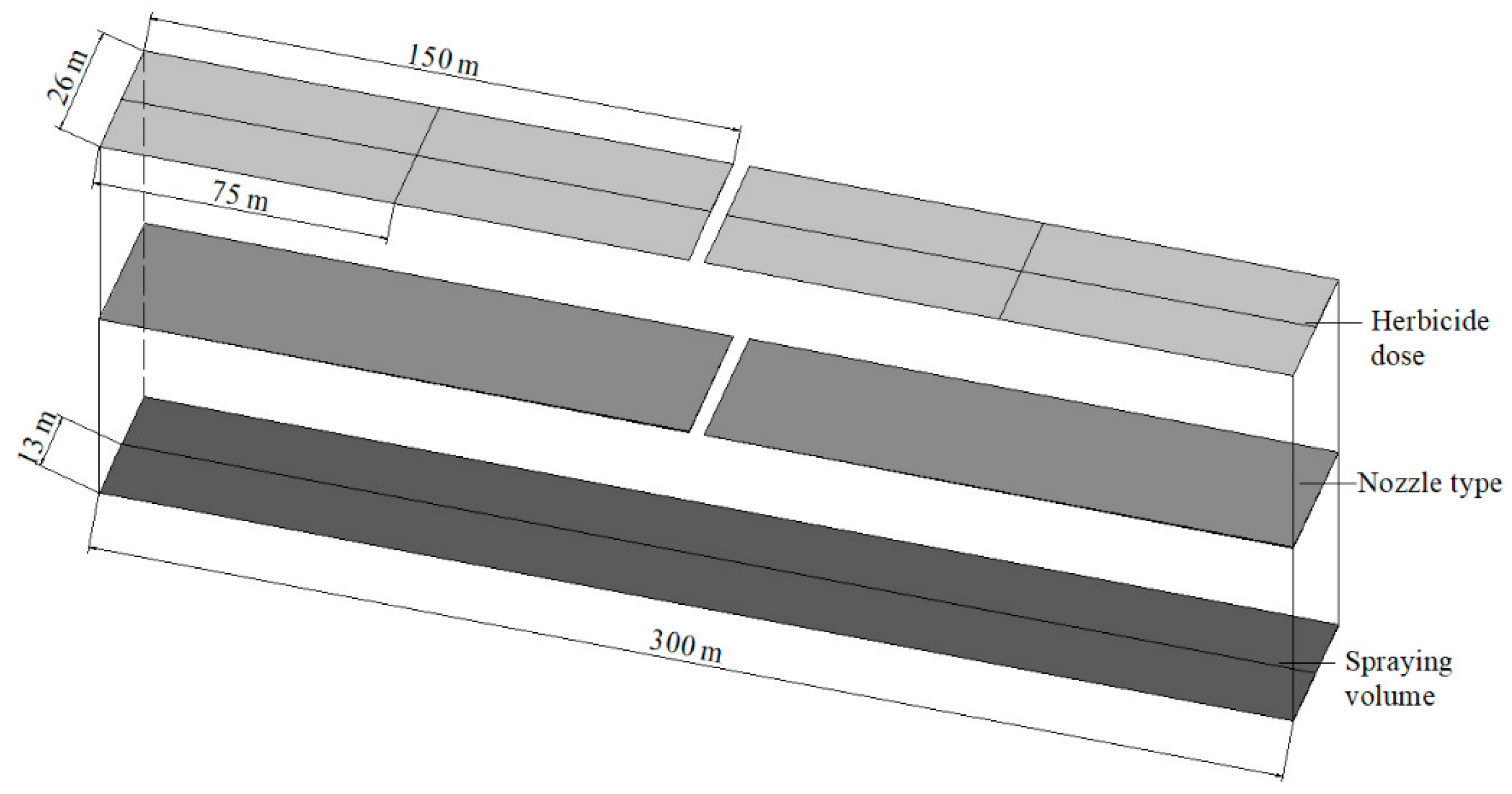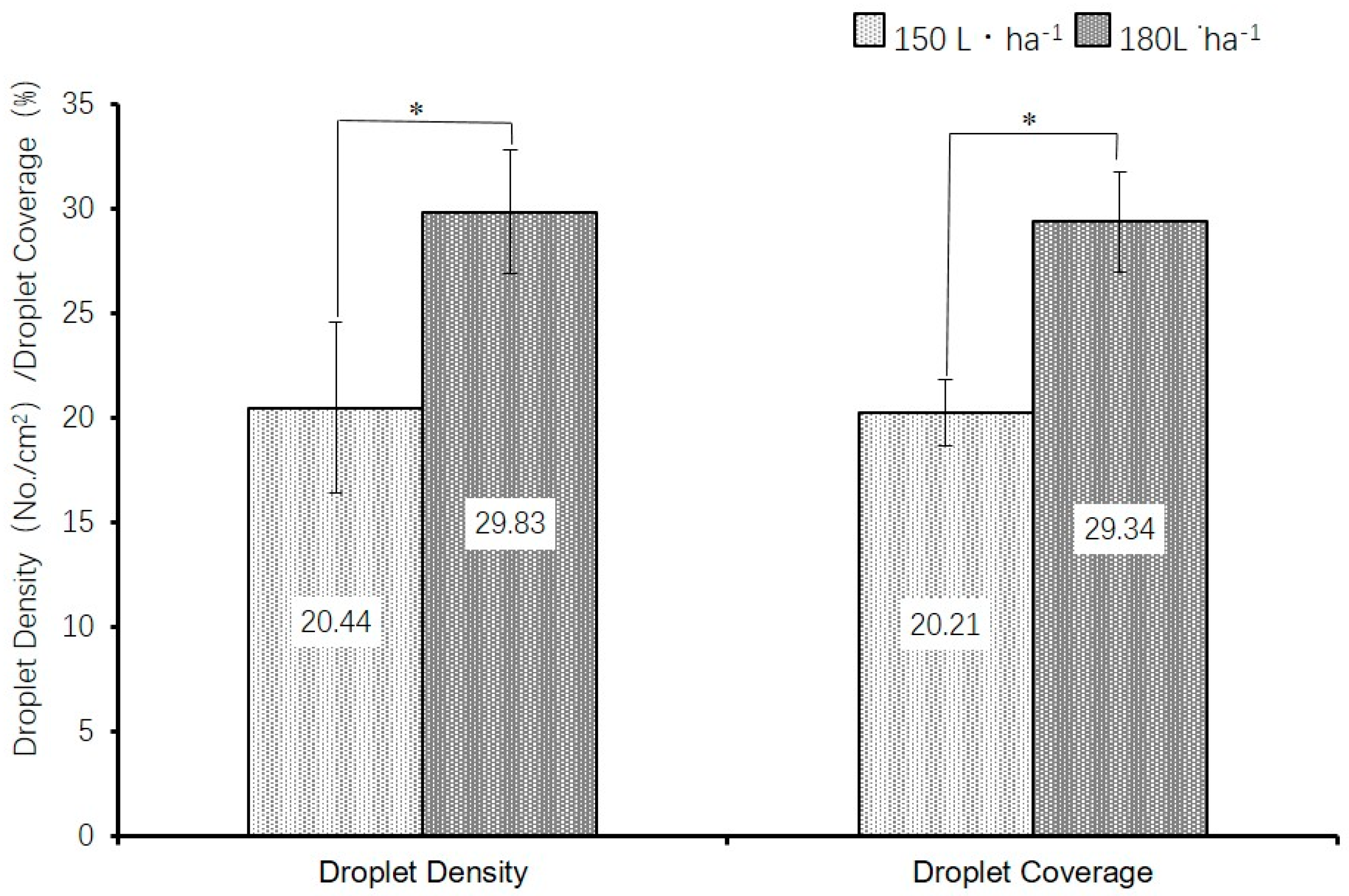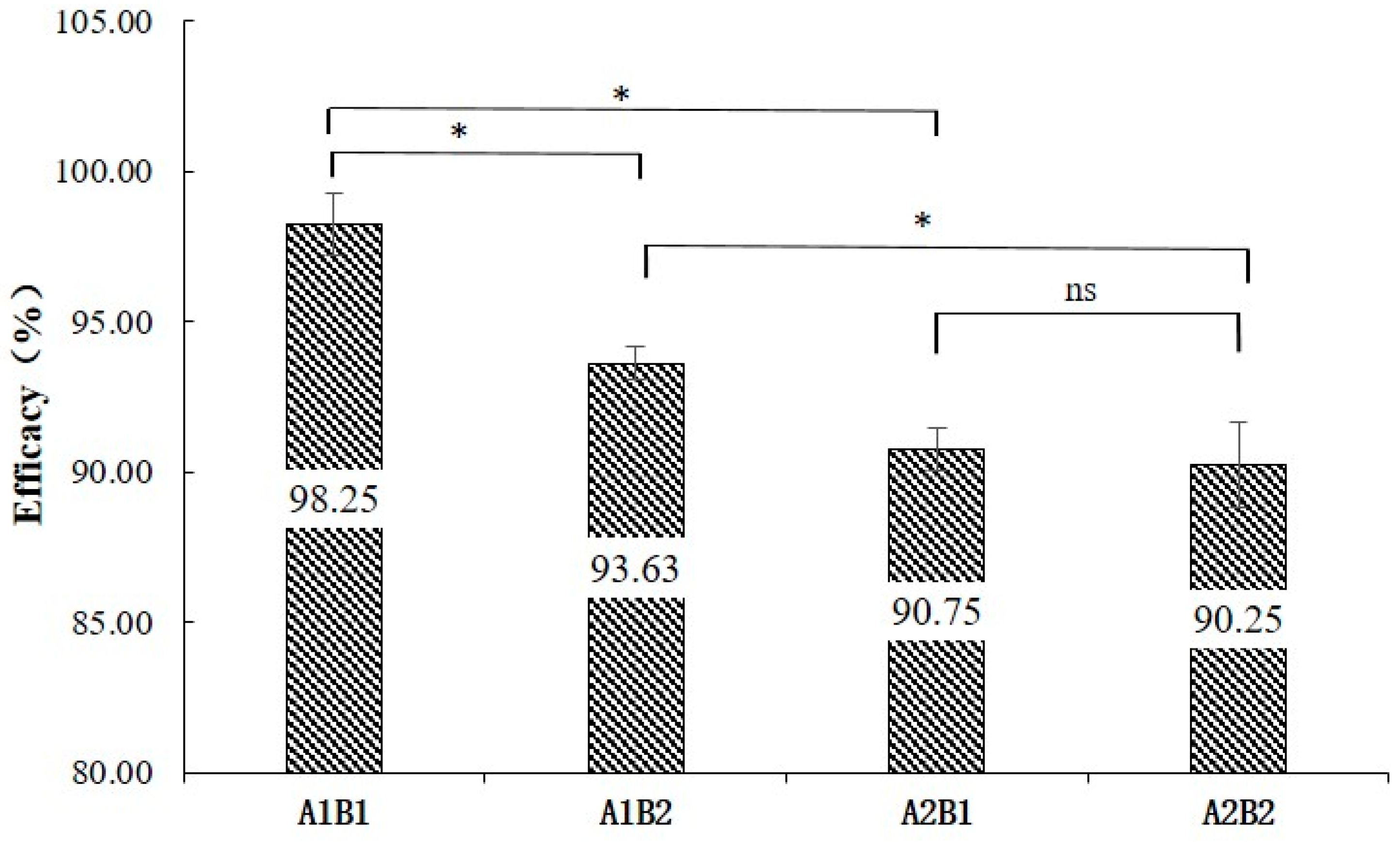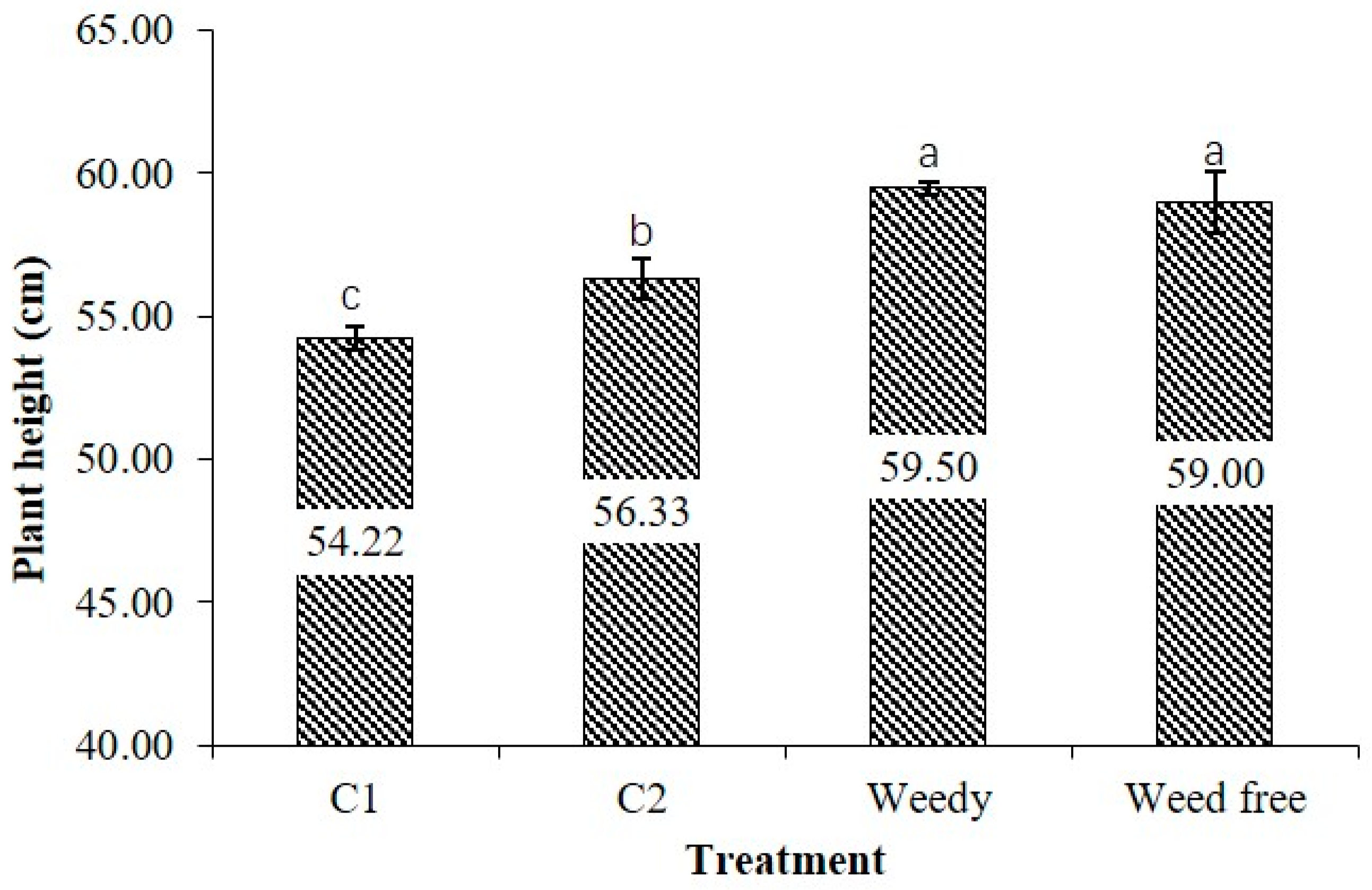Droplet Deposition and Efficacy of Real-Time Variable-Rate Application of Herbicides at Reduced Dose in Winter Wheat Fields
Abstract
1. Introduction
2. Materials and Methods
2.1. Experimental Site
2.2. Experimental Materials
2.3. Experimental Methods
2.3.1. Experimental Design
2.3.2. Measurement of Droplet Deposition
2.3.3. Evaluation of Weed Control Efficacy
2.3.4. Evaluation of Wheat Safety
2.4. Data Analysis
3. Results
3.1. Effect on Droplet Deposition
3.2. Efficacy of Weed Control
3.3. Effect on Wheat Growth
3.4. Effect on Wheat Yield
4. Discussion
5. Conclusions
Author Contributions
Funding
Data Availability Statement
Acknowledgments
Conflicts of Interest
References
- Fang, F.; Li, M.; Gao, X.; Li, J.; Li, Y. Occurrence of flixweed (Descurainia sophia) in wheat fields and its influence on wheat yield components. Chin. Agric. Sci. 2015, 48, 2559–2568, (In Chinese with English abstract). [Google Scholar]
- Li, M.; Gao, X.; Li, J.; Fang, F.; Sun, Z. Occurrence Status, control difficulties and control techniques of weeds in winter wheat field in Huang-Huai-Hai region. Shandong Agric. Sci. 2016, 48, 119–124, (In Chinese with English abstract). [Google Scholar]
- He, X. Research and development of efficient plant protection equipment and precision spraying technology in China: A review. J. Plant Prot. 2022, 49, 389–397, (In Chinese with English abstract). [Google Scholar]
- Chen, S.; Lan, Y.; Li, J.; Xu, X.; Wang, Z.; Peng, B. Evaluation and test of effective spraying width of aerial spraying on plant protection UAV. Trans. CSAE 2017, 33, 82–90, (In Chinese with English abstract). [Google Scholar]
- Tang, F.; Lenzen, M.; Mcbratney, A.; Maggi, F. Risk of pesticide pollution at the global scale. Nat. Geosci. 2021, 14, 206–210. [Google Scholar] [CrossRef]
- Zhuang, L.; Li, G.; Qin, W. Development status of plant protection machinery in China. Agric. Eng. 2021, 11, 9–13, (In Chinese with English abstract). [Google Scholar]
- He, X. Research progress and developmental recommendations on precision spraying technology and equipment in China. Smart Agric. 2020, 2, 133–146, (In Chinese with English abstract). [Google Scholar]
- Zhang, J.; Wang, S.; Zhao, X.; Song, J.; Wang, X. Control efficacy against Descurainia sophia and winter wheat safety of tribenuron-methyl applied by intelligent machine at reduced dose. Plant Prot. 2018, 44, 195–199+204, (In Chinese with English abstract). [Google Scholar]
- Zhang, B.; Zhai, C.; Li, H.; Yang, S. Development status analysis of precision pesticide application techniques and equipments. J. Agric. Mech. Res. 2016, 38, 1–5+28, (In Chinese with English abstract). [Google Scholar]
- Facchinetti, D.; Santoro, S.; Galli, L.E.; Fontana, G.; Fedeli, L.; Parisi, S.; Bonacchi, L.B.; Šušnjar, S.; Salvai, F.; Coppola, G.; et al. Reduction of pesticide use in fresh-cut salad production through artificial intelligence. Appl. Sci. 2021, 11, 1992. [Google Scholar] [CrossRef]
- Abbas, I.; Liu, J.; Faheem, M.; Noor, R.S.; Shaikh, S.; Solangi, K.A.; Raza, S.M. Different sensor based intelligent spraying systems in agriculture. Sens. Actuators A-Phys. 2020, 316, 112265. [Google Scholar] [CrossRef]
- Virk, S.S.; Prostko, E.P. Survey of pesticide application practices and technologies in Georgia agronomic crops. Weed Technol. 2022, 36, 616–628. [Google Scholar] [CrossRef]
- Rai, N.; Zhang, Y.; Ram, B.G.; Schumacher, L.; Yellavajjala, R.K.; Bajwa, S.; Sun, X. Applications of deep learning in precision weed management: A review. Comput. Electron. Agric. 2023, 206, 107698. [Google Scholar] [CrossRef]
- Allmendinger, A.; Spaeth, M.; Saile, M.; Peteinatos, G.; Gerhards, R. Precision chemical weed management strategies: A review and a design of a new CNN-based modular spot sprayer. Agronomy 2022, 12, 1620. [Google Scholar] [CrossRef]
- He, Y.; Xiao, S.; Fang, H.; Dong, T.; Tang, Y.; Nie, P.; Wu, J.; Luo, S. Development situation and spraying decision of spray nozzle for plant protection UAV. Trans. CSAE 2018, 34, 113–124, (In Chinese with English abstract). [Google Scholar]
- Balsari, P.; Gil, E.; Marucco, P.; van de Zande, J.C.; Nuyttens, D.; Herbst, A.; Gallart, M. Field-crop-sprayer potential drift measured using test bench: Effects of boom height and nozzle type. Biosyst. Eng. 2017, 154, 3–13. [Google Scholar]
- Nuyttens, D.; Baetens, K.; De Schampheleire, M.; Sonck, B. Effect of nozzle type, size and pressure on spray droplet characteristics. Biosyst. Eng. 2007, 97, 333–345. [Google Scholar]
- Knoche, M. Effect of droplet size and carrier volume on performance of foliage-applied herbicides. Crop Prot. 1994, 13, 163–178. [Google Scholar] [CrossRef]
- Butts, T.R.; Samples, C.A.; Franca, L.X.; Dodds, D.M.; Reynolds, D.B.; Adams, J.W.; Zollinger, R.K.; Howatt, K.A.; Fritz, B.K.; Hoffmann, W.C.; et al. Spray droplet size and carrier volume effect on dicamba and glufosinate efficacy. Pest Manag. Sci. 2018, 74, 2020–2029. [Google Scholar] [CrossRef] [PubMed]
- Creech, C.F.; Henry, R.S.; Werle, R.; Sandell, L.D.; Hewitt, A.J.; Kruger, G.R. Performance of postemergence herbicides applied at different carrier volume rates. Weed Technol. 2015, 29, 611–624. [Google Scholar] [CrossRef]
- Sperry, B.P.; Ferrell, J.A. Effect of carrier volume and application method on waterhyacinth (Eichhornia crassipes) response to 2,4-D, glyphosate, and diquat. Invasive Plant Sci. Manag. 2021, 14, 29–34. [Google Scholar] [CrossRef]
- Sikkema, P.H.; Brown, L.; Shropshire, C.; Spieser, H.; Soltani, N. Flat fan and air induction nozzles affect soybean herbicide efficacy. Weed Biol. Manag. 2008, 8, 31–38. [Google Scholar] [CrossRef]
- Meyer, C.J.; Norsworthy, J.K.; Kruger, G.R.; Barber, T.L. Effect of nozzle selection and spray volume on droplet size and efficacy of Engenia tank-mix combinations. Weed Technol. 2016, 30, 377–390. [Google Scholar] [CrossRef]
- Souza, L.; Moretti, M.L. Carrier volume and nozzle effect on 2,4-D and glufosinate performances in hazelnut sucker control. HortScience. 2020, 55, 1848–1852. [Google Scholar] [CrossRef]
- Zhang, H.; Dorr, G.; Zheng, J.; Zhou, H. Wind tunnel experiment of influence on droplet size distribution of flat fan nozzles. Trans. CSAM 2012, 43, 53–57, (In Chinese with English abstract). [Google Scholar]
- Liu, Q.; Cooper, S.E.; Qi, L.; Fu, Z. Experimental study of droplet transport time between nozzles and target. Biosyst. Eng. 2006, 95, 151–157. [Google Scholar]
- Wu, X.; Jia, Y.; Luo, B.; Chen, C.; Wang, Y.; Kang, F.; Li, J. Deposition law of flat fan nozzle for pesticide application in horticultural plants. Int. J. Agric. Biol. Eng. 2022, 15, 27–38. [Google Scholar] [CrossRef]
- Xie, C.; He, X.; Song, J.; Herbst, A. Comparative research of two kinds of flat fan nozzle atomization process. Trans. CSAE 2013, 29, 25–30, (In Chinese with English abstract). [Google Scholar]
- Li, C.; Wu, J.; Pan, X.; Dou, H.; Zhao, X.; Gao, Y.; Yang, S.; Zhai, C. Design and Experiment of a Breakpoint Continuous Spraying System for Automatic-Guidance Boom Sprayers. Agriculture 2023, 13, 2203. [Google Scholar] [CrossRef]
- Xu, G.; Zhang, R.; Chen, L.; Tang, Q.; Xu, M.; Zhang, W. Assessing the ability of image processing methods of droplets spayed on water sensitive papers for aerial application. In Computer and Computing Technologies in Agriculture X, Proceedings of the CCTA 2016, IFIP Advances in Information and Communication Technology, Dongying, China, 19–21 October 2016; Li, D., Ed.; Springer: Cham, Switzerland, 2019; Volume 509, p. 509. [Google Scholar]
- Luck, J.D.; Sharda, A.; Pitla, S.K.; Fulton, J.P.; Shearer, S.A. A case study concerning the effects of controller response and turning movements on application rate uniformity with a self-propelled sprayer. Trans. ASABE 2011, 54, 423–431. [Google Scholar] [CrossRef]
- Reddy, K.N.; Hoagland, R.E.; Zablotowicz, R.M. Effect of glyphosate growth, chlorophyll, and nodulation in glyphosate-resistant and susceptible soybean (Glycine max) varieties. J. New Seeds 2000, 2, 37–52. [Google Scholar] [CrossRef]
- Reddy, K.N.; Zablotowicz, R.M. Glyphosate-resistant soybean response to various salts of glyphosate and glyphosate accumulation in soybean nodules. Weed Sci. 2003, 51, 496–502. [Google Scholar] [CrossRef]
- Cox, W.J.; Hanh, R.R.; Stachowski, P.J. Time of weed removal with glyphosate affects corn growth and yield components. Agron. J. 2006, 98, 349–353. [Google Scholar]
- Shafagh-Kolvanagh, J.; Zehtab-Salmasi, S.; Javanshir, A.; Moghaddam, M.; Nasab, A.D.M. Effects of nitrogen and duration of weed interference on grain yield and SPAD (chlorophyll) value of soybean (Glycine max (L.) Merr.). J. Food Agric. Environ. 2008, 6, 368–373. [Google Scholar]
- Simão, L.M.; Easterly, A.C.; Kruger, G.R.; Creech, C.F. Herbicide spray deposition in wheat stubble as affected by nozzle type and application direction. Agronomy 2020, 10, 1507. [Google Scholar] [CrossRef]
- Legleiter, T.R.; Young, B.G.; Johnson, W.G. Influence of broadcast spray nozzle on the deposition, absorption, and efficacy of dicamba plus glyphosate on four glyphosate-resistant dicot weed species. Weed Technol. 2017, 32, 174–181. [Google Scholar] [CrossRef]
- Gauvrit, C.; Lamrani, T. Influence of application volume on the efficacy of clodinafop-propargyl and fenoxaprop-P-ethyl on oats. Weed Res. 2008, 48, 78–84. [Google Scholar]
- Borger, C.P.; Riethmuller, G.P.; Ashworth, M.; Minkey, D.; Hashem, A.; Powles, S.B. Increased carrier volume improves preemergence control of rigid ryegrass (Lolium rigidum) in zero-tillage seeding systems. Weed Technol. 2013, 27, 649–655. [Google Scholar]
- Creech, C.F.; Henry, R.S.; Fritz, B.K.; Kruger, G.R. Influence of herbicide active ingredient, nozzle type, orifice size, spray pressure, and carrier volume rate on spray droplet size characteristics. Weed Technol. 2016, 29, 298–310. [Google Scholar] [CrossRef]
- Lenik, M.; Kramberger, B.; Vajs, S. The effects of drift-reducing nozzles on herbicide efficacy and maize (Zea mays L.) yield. Zemdirbyste 2012, 99, 371–378. [Google Scholar]
- China Ministry of Agriculture and Rural Affairs. National Planting Development Plan for the 14th Five-Year. 29 December 2021. Available online: http://www.moa.gov.cn/govpublic/ZZYGLS/202201/t20220113_6386808.htm (accessed on 14 December 2023).







| Treatment | Spraying Volume (L/ha) | Width of Spraying Boom (m) | Travel Speed (km/h) | Total No. of Nozzles on the Spraying Boom | Theoretical Working Time per Hectare (min) | Theoretical Flow Rate per Nozzle (L/min) |
|---|---|---|---|---|---|---|
| 1 | 150 | 13 | 5 | 26 | 9.23 | 0.63 |
| 2 | 150 | 13 | 6 | 26 | 7.69 | 0.75 |
| 3 | 150 | 13 | 7 | 26 | 6.59 | 0.88 |
| 4 | 150 | 13 | 8 | 26 | 5.77 | 1.00 |
| 5 | 180 | 13 | 5 | 26 | 9.23 | 0.75 |
| 6 | 180 | 13 | 6 | 26 | 7.69 | 0.90 |
| 7 | 180 | 13 | 7 | 26 | 6.59 | 1.05 |
| 8 | 180 | 13 | 8 | 26 | 5.77 | 1.20 |
| Indexes | p-Value (n = 52) | ||
|---|---|---|---|
| Spraying Volume | Nozzle Size | Spraying Volume × Nozzle Size | |
| Droplet density | 0.000 | 0.551 | 0.131 |
| Droplet coverage | 0.000 | 0.130 | 0.233 |
| Mean coefficient of variation | 0.577 | 0.138 | 0.267 |
| Source of Variation | p-Value (n = 12) |
|---|---|
| Spraying volume | 0.000 |
| Nozzle size | 0.140 |
| Herbicide dose | 0.186 |
| Spraying volume × Nozzle size | 0.043 |
| Spraying volume × Herbicide dose | 0.848 |
| Nozzle size × Herbicide dose | 0.949 |
| Spraying volume × Nozzle size × Herbicide dose | 0.654 |
| Source of Variation | p-Value (n = 12) | |||
|---|---|---|---|---|
| No. of Ears/m2 | No. of Kernels/Ear | Thousand Kernels Weight | Yield | |
| Spraying volume | 0.327 | 0.378 | 0.275 | 0.727 |
| Nozzle size | 0.642 | 0.238 | 0.847 | 0.742 |
| Herbicide dose | 0.660 | 0.543 | 0.709 | 0.741 |
| Spraying volume × Nozzle size | 0.843 | 0.425 | 0.506 | 0.581 |
| Spraying volume × Herbicide dose | 0.660 | 0.246 | 0.464 | 0.929 |
| Nozzle size × Herbicide dose | 0.707 | 0.815 | 0.167 | 0.098 |
| Spraying volume × Nozzle size × Herbicide dose | 0.745 | 0.947 | 0.256 | 0.891 |
| Treatment | Parameters (n = 12) | Parameters (n = 48) | ||||||
|---|---|---|---|---|---|---|---|---|
| Spraying Volume | Nozzle Size | Dose | No. of Ears/m2 | No. of Kernels/Ear | Thousand Kernels Weight (g) | Yield (t·ha−1) | Average of Yield (t·ha−1) | Yield Loss * (%) |
| 180 L·ha−1 | TTI11004 | Recommended | 733.60 ± 11.19 | 24.80 ± 0.78 | 28.02 ± 0.83 | 6.35 ± 0.06 | 6.17 ± 0.06 | 9.13 |
| 180 L·ha−1 | TTI11003 | Recommended | 756.80 ± 12.97 | 25.17 ± 0.59 | 26.03 ± 0.94 | 6.18 ± 0.09 | ||
| 150 L·ha−1 | TTI11004 | Recommended | 728.00 ± 37.51 | 23.65 ± 0.35 | 26.92 ± 0.74 | 6.10 ± 0.44 | ||
| 150 L·ha−1 | TTI11003 | Recommended | 765.60 ± 44.27 | 24.43 ± 1.10 | 27.48 ± 0.36 | 6.06 ± 0.07 | ||
| 180 L·ha−1 | TTI11004 | 20% Reduced | 734.40 ± 50.47 | 24.58 ± 0.85 | 28.90 ± 0.66 | 6.48 ± 0.32 | 6.33 ± 0.08 | 6.77 |
| 180 L·ha−1 | TTI11003 | 20% Reduced | 888.80 ± 25.21 | 22.64 ± 0.51 | 25.65 ± 0.41 | 6.45 ± 0.24 | ||
| 150 L·ha−1 | TTI11004 | 20% Reduced | 663.20 ± 29.63 | 26.16 ± 0.52 | 27.43 ± 0.75 | 6.14 ± 0.18 | ||
| 150 L·ha−1 | TTI11003 | 20% Reduced | 685.60 ± 13.85 | 25.91 ± 0.79 | 29.27 ± 0.72 | 6.26 ± 0.17 | ||
| Weedy (n = 32) | 742.40 ± 56.45 | 23.71 ± 1.06 | 26.11 ± 0.86 | 4.86 ± 0.19 | -- | -- | ||
| Weed-free (n = 32) | 630.40 ± 11.16 | 25.85 ± 1.04 | 28.62 ± 0.81 | 6.79 ± 0.17 | -- | -- | ||
Disclaimer/Publisher’s Note: The statements, opinions and data contained in all publications are solely those of the individual author(s) and contributor(s) and not of MDPI and/or the editor(s). MDPI and/or the editor(s) disclaim responsibility for any injury to people or property resulting from any ideas, methods, instructions or products referred to in the content. |
© 2024 by the authors. Licensee MDPI, Basel, Switzerland. This article is an open access article distributed under the terms and conditions of the Creative Commons Attribution (CC BY) license (https://creativecommons.org/licenses/by/4.0/).
Share and Cite
Zhang, J.; Xu, X.; Lv, Y.; Zhao, X.; Song, J.; Yu, P.; Wang, X.; Zhao, E. Droplet Deposition and Efficacy of Real-Time Variable-Rate Application of Herbicides at Reduced Dose in Winter Wheat Fields. Agronomy 2024, 14, 211. https://doi.org/10.3390/agronomy14010211
Zhang J, Xu X, Lv Y, Zhao X, Song J, Yu P, Wang X, Zhao E. Droplet Deposition and Efficacy of Real-Time Variable-Rate Application of Herbicides at Reduced Dose in Winter Wheat Fields. Agronomy. 2024; 14(1):211. https://doi.org/10.3390/agronomy14010211
Chicago/Turabian StyleZhang, Jinwei, Xian Xu, Yuan Lv, Xueguan Zhao, Jian Song, Pingzhong Yu, Xiu Wang, and Ercheng Zhao. 2024. "Droplet Deposition and Efficacy of Real-Time Variable-Rate Application of Herbicides at Reduced Dose in Winter Wheat Fields" Agronomy 14, no. 1: 211. https://doi.org/10.3390/agronomy14010211
APA StyleZhang, J., Xu, X., Lv, Y., Zhao, X., Song, J., Yu, P., Wang, X., & Zhao, E. (2024). Droplet Deposition and Efficacy of Real-Time Variable-Rate Application of Herbicides at Reduced Dose in Winter Wheat Fields. Agronomy, 14(1), 211. https://doi.org/10.3390/agronomy14010211







